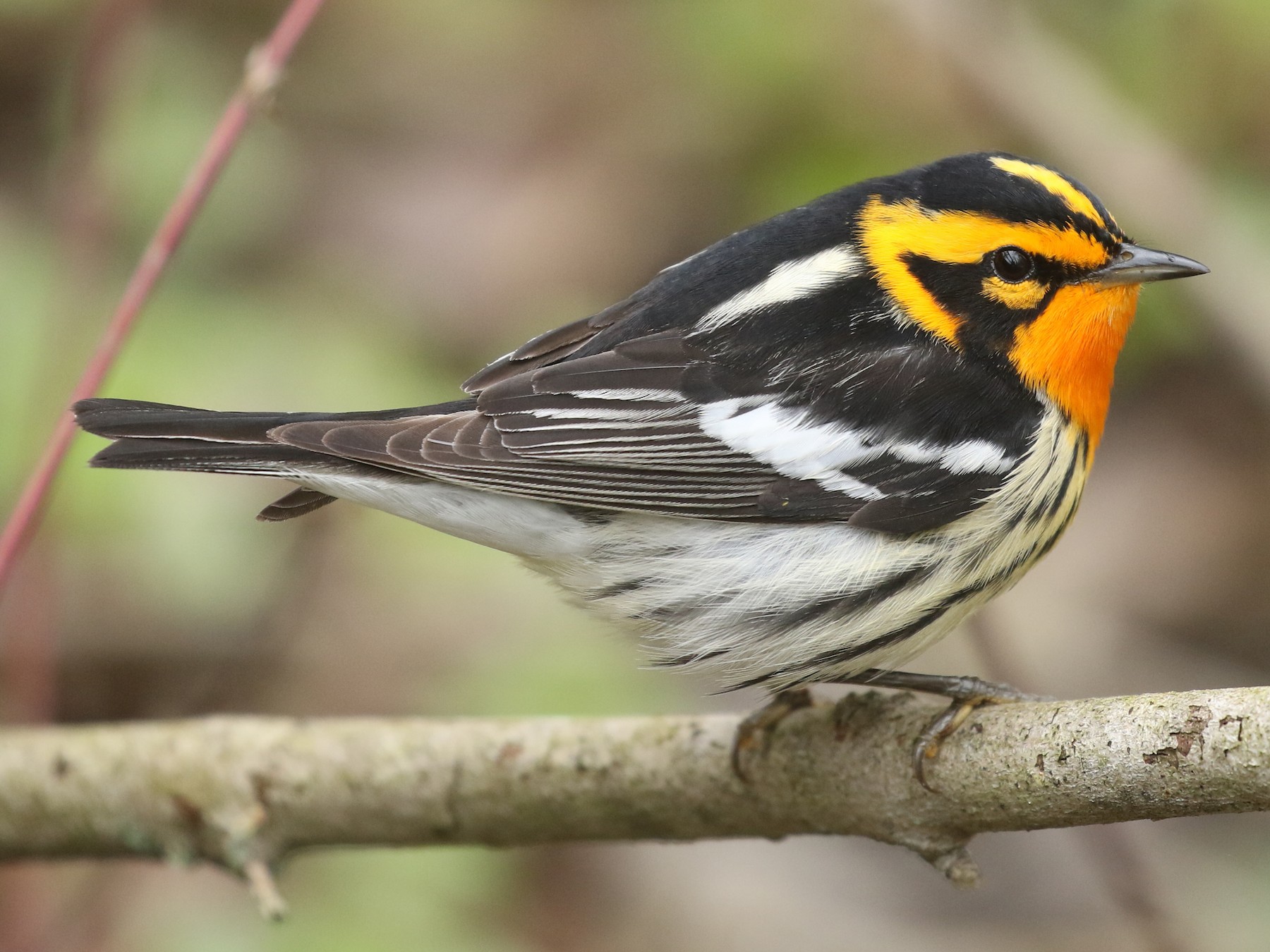Florida is home to numerous yellow birds throughout the year, as various species either reside here permanently or migrate from northern regions to escape harsh winters.
To aid in the identification of yellow birds in Florida, this comprehensive guide offers pictures, information on distinguishing features, recordings of their unique songs, and details about their migration patterns.
Warblers, orioles, and tanagers are the most common yellow birds found in Florida. Additionally, female birds of these species sometimes exhibit distinct appearances from their male counterparts.
This guide organizes the yellow birds in order of their frequency of sightings in Florida during the spring and summer months (May and June), based on ebird checklists.
Yellow birds present in Florida throughout the year include the White-eyed Vireo, Common Yellowthroat, Pine Warbler, Prairie Warbler, Yellow-throated Warbler, and Eastern Meadowlark.
During the summer, one can spot species such as the Summer Tanager, Yellow-throated Vireo, Hooded Warbler, Prothonotary Warbler, Spot-breasted Oriole, and Dickcissel.
In winter, the following yellow birds make appearances in Florida: Palm Warbler, Yellow-rumped Warbler, Painted Bunting, American Goldfinch, Cedar Waxwing, Orange-crowned Warbler, Baltimore Oriole, Black-throated Green Warbler, Western Kingbird, Western Tanager, Wilson’s Warbler, and Yellow-headed Blackbird.
When it comes to migration, keep an eye out for American Redstart, Cape May Warbler, Yellow Warbler, Magnolia Warbler, Scarlet Tanager, Blue-winged Warbler, Nashville Warbler, and Canada Warbler.
Additionally, there are accidental sightings of yellow birds in Florida, including the Tropical Kingbird, Hooded Oriole, Scott’s Oriole, Western Meadowlark, Evening Grosbeak, Lesser Goldfinch, Couch’s Kingbird, and Eastern Yellow Wagtail.
By delving into this guide, you’ll gain valuable knowledge to help you identify the yellow birds you’ve encountered in Florida.
In total, there are 32 different yellow bird species found in Florida, each with its own distinct characteristics and behaviors.
Let’s explore a few examples in detail:
1. Palm Warbler
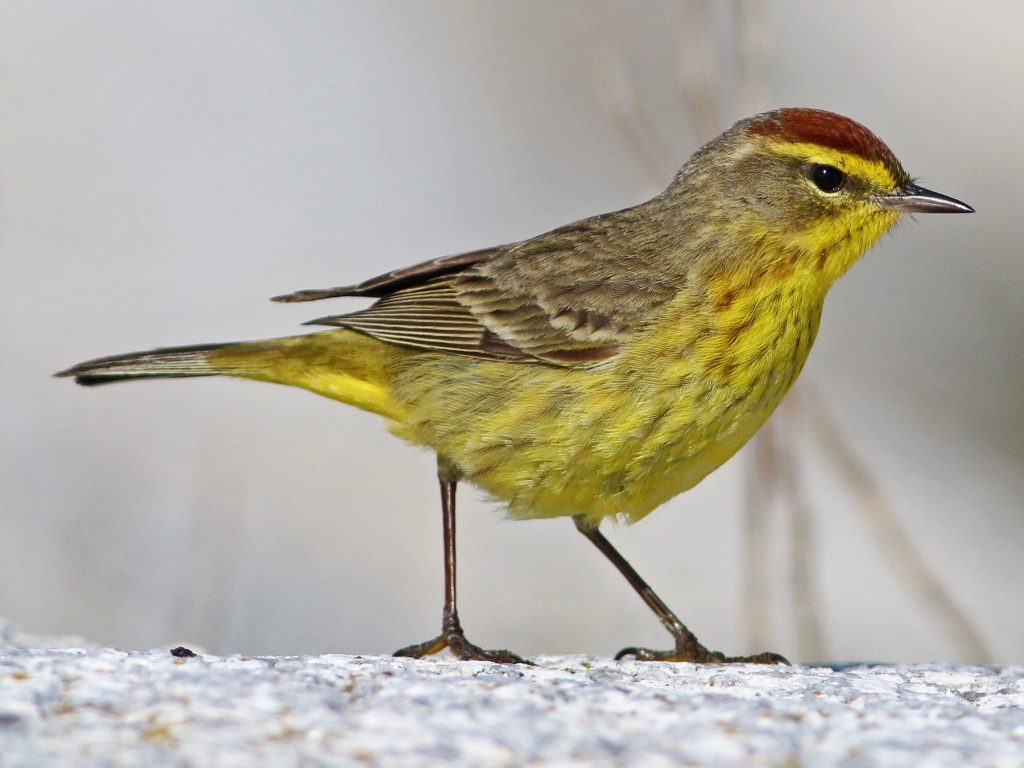
Palm Warblers are predominantly seen during winter in Florida, typically from September to May. They are recorded in around 40% of winter checklists submitted by birdwatchers.
Featuring a rusty red patch atop their heads, Palm Warblers exhibit a brown-olive hue across their bodies. While they breed in Canada, they can be found in Florida throughout the year, particularly along the southern coast.
Characteristics:
– Length: 4.7-5.5 inches (12-14 cm)
– Weight: 0.3-0.5 ounces (7-13 g)
– Wingspan: 7.9-8.3 inches (20-21 cm)
Palm Warblers predominantly breed in Canada and can be observed during migration in eastern US states. Some individuals opt to spend their winters in Florida and along the southeastern coast.
These birds are often spotted foraging for insects along the ground, often accompanied by other species like Sparrows, Juncos, and Yellow-rumped Warblers.
2. Yellow-rumped Warbler
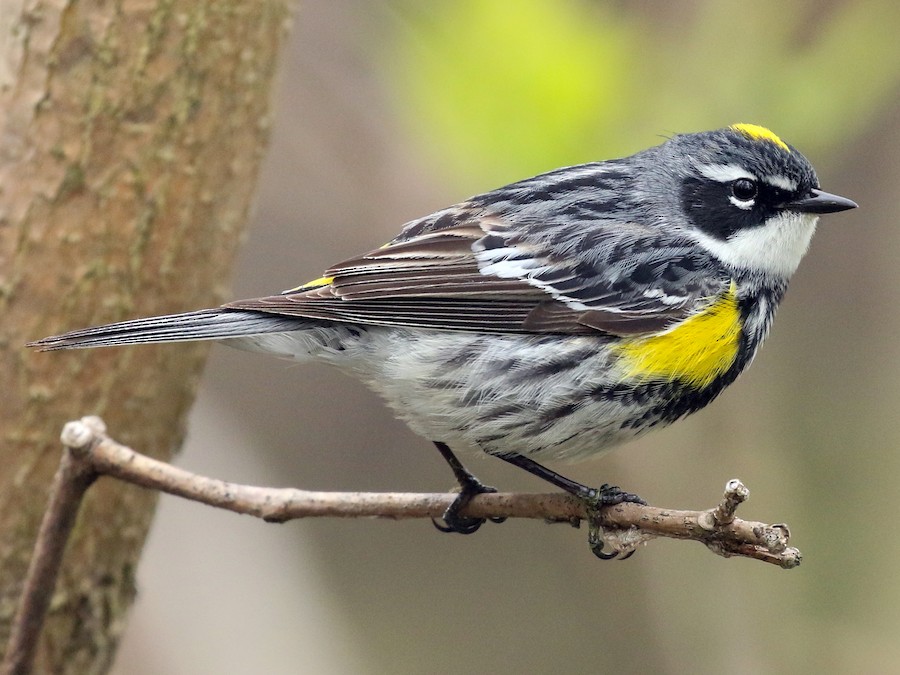
Yellow-rumped Warblers are typically sighted in Florida during winter, with their arrival commencing in September. The best months for spotting them are from October to April. They feature in approximately 37% of winter checklists.
These warblers exhibit gray plumage with yellow flashes on their faces, sides, and rumps, as well as white wings. Female Yellow-rumped Warblers may possess slightly browner hues, while winter birds showcase paler brown shades with bright yellow rumps and sides, transitioning back to gray and yellow in the spring.
Characteristics:
– Length: 4.7-5.5 inches (12-14 cm)
– Weight: 0.4-0.5 ounces (12-13 g)
– Wingspan: 7.5-9.1 inches (19-23 cm)
Primarily breeding in Canada, as well as parts of the Rockies and the Appalachian mountains, Yellow-rumped Warblers can be observed during migration in the Midwest. During winter, they inhabit open areas with fruiting shrubs. Their diet consists mainly of insects during summer and migration, while they predominantly consume fruit in winter, including bayberry and wax myrtle.
3. White-eyed Vireo
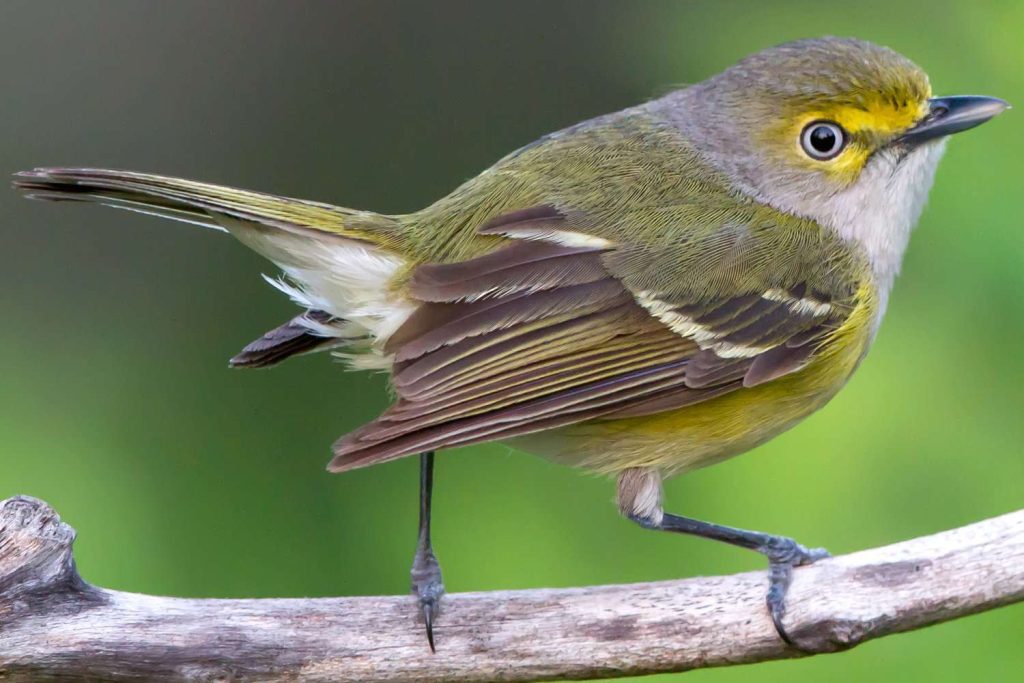
White-eyed Vireos can be spotted in Florida throughout the year, though they are more common between March and October. They are present in approximately 13% of summer checklists and 8% of winter checklists.
These vireos possess gray heads with yellow markings around their foreheads, accompanied by distinct white eyes. Their chests and throats are white, while they exhibit yellow sides, greenish backs, and darker wings adorned with two white wingbars.
Characteristics:
– Length: 4.3-5.1 inches (11-13 cm)
– Weight: 0.3-0.5 ounces (10-14 g)
– Wingspan: 6.7 inches (17 cm)
White-eyed Vireos spend their summers concealed in thickets across the southeastern United States, while those near the coast remain year-round. During winter, they migrate to the southeast coast of Mexico and the Caribbean.
These vireos can be found in overgrown pastures and brambles, where they feed on insects, flies, and spiders. In winter, their diet expands to include berries.
4. Common Yellowthroat
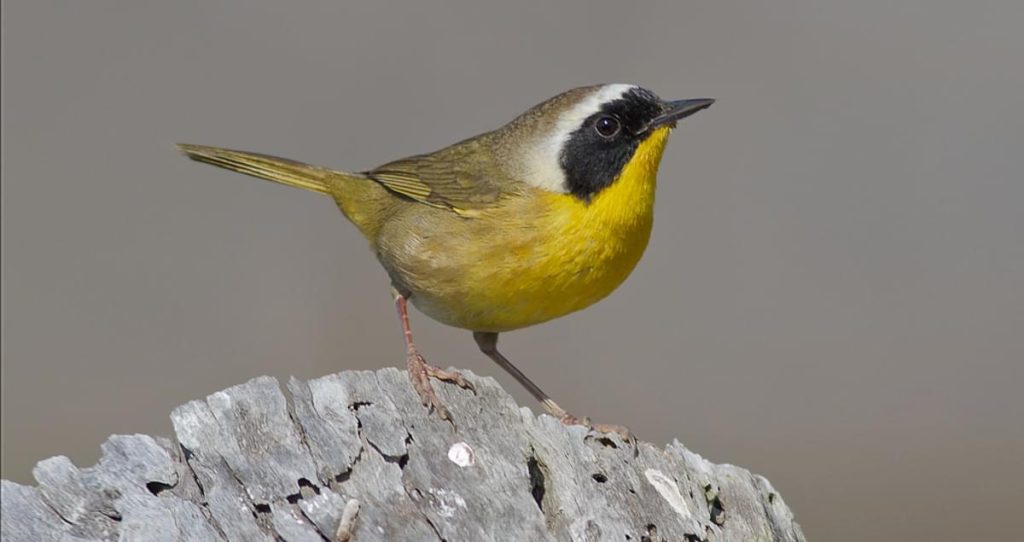
Common Yellowthroats can be observed in Florida throughout the year, appearing in around 7% of summer checklists and 11% of winter checklists.
These small songbirds boast brownish plumage on their backs and bright yellow undersides, accompanied by long tails. Males sport black masks across their faces, while the intensity of their yellow coloration may vary geographically. Females tend to exhibit a more olive appearance beneath their plumage.
Characteristics:
– Length: 4.3-5.1 inches (11-13 cm)
– Weight: 0.3-0.3 ounces (9-10 g)
– Wingspan: 5.9-7.5 inches (15-19 cm)
During the summer, Common Yellowthroats breed across most of North America, excluding Alaska and northern Canada. While some reside along the Gulf Coast and Pacific Southwest throughout the year, others migrate south for the winter.
These birds are commonly found in marshy or wetland areas and brushy fields, often inhabiting thick, tangled vegetation.
5. Pine Warbler
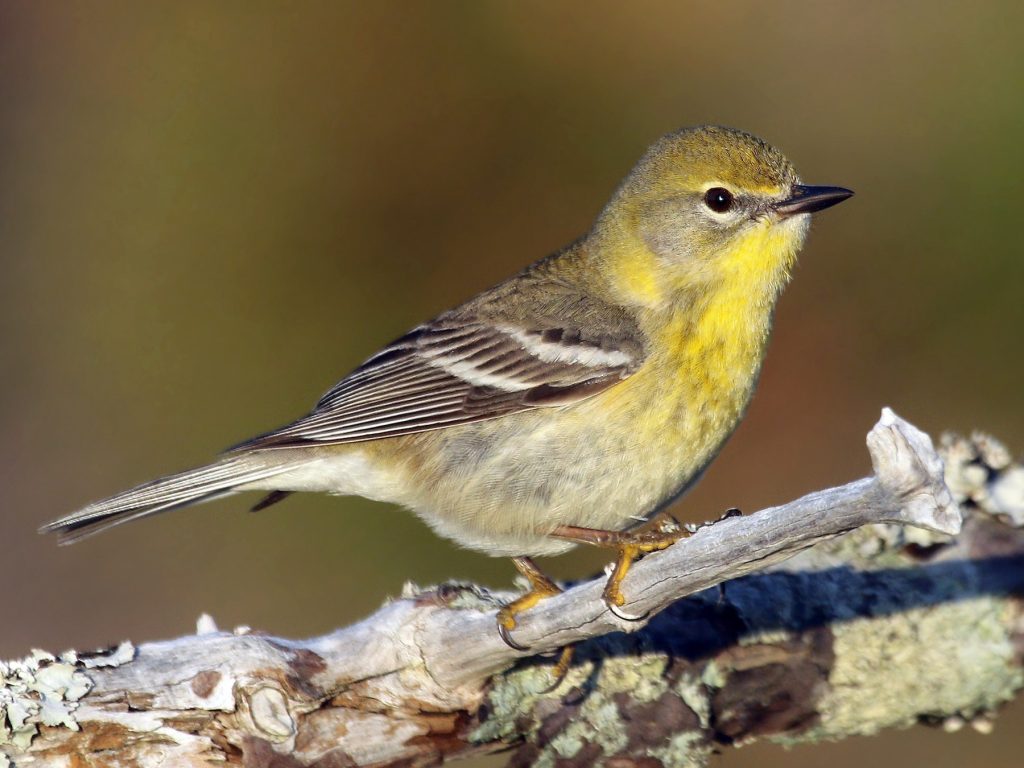
Pine Warblers can be spotted in Florida year-round, but they are more frequently observed during winter in the southern regions of the state. They appear in approximately 5% of summer checklists and 12% of winter checklists.
These plump yellow birds possess olive-colored backs, white lower bellies, and gray wingbars. Female Pine Warblers may display a browner appearance and possess additional white on their bellies.
Characteristics:
– Length: 5.1-5.5 inches (13-14 cm)
– Weight: 0.3-0.5 ounces (9-15 g)
– Wingspan: 7.5-9.1 inches (19-23 cm)
Pine Warblers predominantly breed in northeastern US states before migrating
to southeastern US states. However, some individuals remain in southeastern US states year-round.
These warblers inhabit pine forests, often perching high in the trees. Their diet primarily consists of caterpillars, beetles, spiders, and other insects and larvae. In colder weather, they may also consume fruit and seeds.
By familiarizing yourself with the information provided in this guide, identifying yellow birds in Florida will become significantly easier. Whether you’ve spotted a Palm Warbler, Yellow-rumped Warbler, White-eyed Vireo, Common Yellowthroat, Pine Warbler, or any other species, this guide equips you with the knowledge to appreciate and identify these beautiful avian creatures.
6. Prairie Warbler
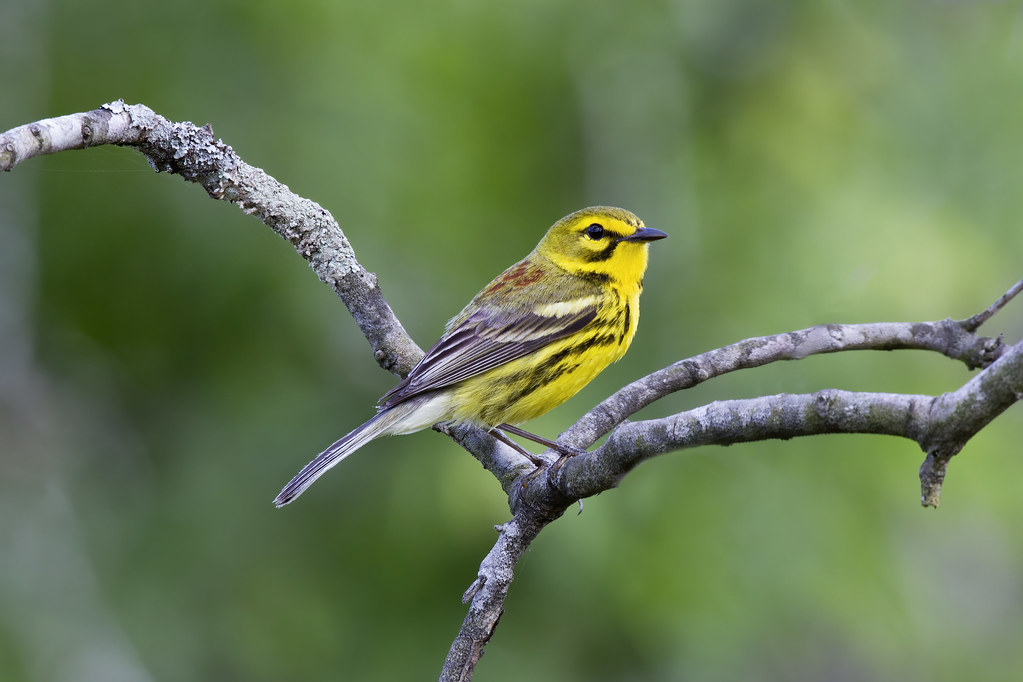
Prairie Warblers spend their breeding season in northern Florida and migrate to other parts of the state during winter. Their numbers increase during the migrations occurring from March to April and September to October. Prairie Warblers are present in approximately 2% of summer checklists, 4% of winter checklists, and up to 18% of checklists during migration.
These small songbirds have olive-green backs and yellow throats and bellies. They feature black streaks on their sides and a dark semicircle under their eyes. Female Prairie Warblers exhibit duller coloration compared to males.
Characteristics:
– Length: 4.3 inches (11 cm)
– Weight: 0.2-0.3 ounces (6.4-8.8 g)
Prairie Warblers breed in eastern and southeastern US states, and they spend their winters in Florida, the Caribbean, and along the Gulf Coast into Central America. Some individuals remain resident in Florida throughout the year, forming separate subspecies that are slightly larger in size.
These warblers can often be found in fields and forests, where they feed on insects, spiders, and snails. You may spot them bobbing their tails while foraging along branches.
7. Yellow-throated Warbler
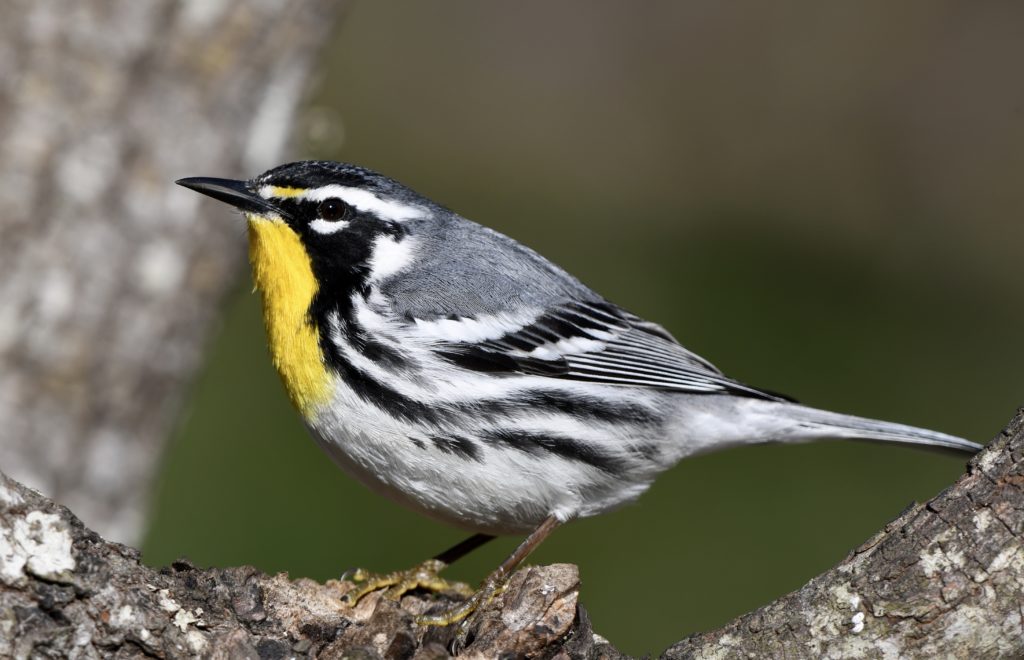
Yellow-throated Warblers are primarily seen in southern Florida during the winter, and some individuals stay there year-round. However, they are most commonly observed during the fall migration, specifically in September and October. Their presence can be noted in up to 18% of checklists during this time.
These warblers possess gray and white bodies adorned with black stripes and vibrant yellow throats. When viewed from below, they exhibit white bellies and tails. Females and juveniles have paler coloration.
Characteristics:
– Length: 5.1-5.5 inches (13-14 cm)
– Weight: 0.3-0.4 ounces (9-11 g)
– Wingspan: 8.3 inches (21 cm)
Yellow-throated Warblers breed across the southeastern US states and spend their winters in Florida, the Caribbean, and along the Gulf Coast, extending into Central America. Some individuals may remain in Florida throughout the year.
These warblers can typically be found perched at the tops of pine trees, searching for insects. However, during migration, they may forage at lower levels.
8. American Redstart Female
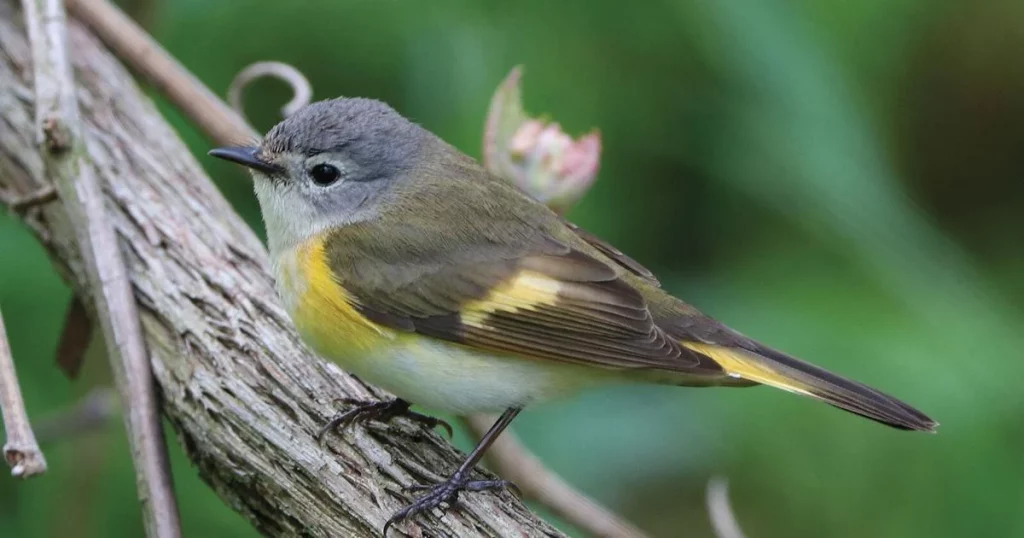
Female American Redstarts are frequently observed during migration in Florida, typically in April to May and August to October. However, some individuals spend their winters in the southern part of the state. They appear in approximately 1% of winter checklists and up to 27% of checklists during fall migration.
Male American Redstarts boast predominantly black plumage with bright orange patches and a white belly. Females, on the other hand, display an olive-gray coloration with numerous yellow patches.
Characteristics:
– Length: 4.3-5.1 inches (11-13 cm)
– Weight: 0.2-0.3 ounces (6-9 g)
– Wingspan: 6.3-7.5 inches (16-19 cm)
American Redstarts breed in eastern US states, Canada, and northwestern US states. During migration, they can also be spotted in central and western US states.
These warblers inhabit deciduous woodlands, feasting on insects. They can also be found in backyard settings and thickets, where they consume berries such as serviceberry and magnolia.
9. Painted Bunting – Female

Painted Buntings are more commonly seen in southern Florida during winter, accounting for approximately 5% of checklists at this time.
Male Painted
Buntings feature vibrant patchworks of color, primarily red underneath, with striking blue heads, green wings, and backs. In contrast, females exhibit bright yellow-green hues.
Characteristics:
– Length: 4.7-5.1 inches (12-13 cm)
– Weight: 0.5-0.7 ounces (13-19 g)
Painted Buntings breed in specific US states, mainly in the south-central and some coastal areas of the southeastern region. They migrate to Central America, southern Florida, and select Caribbean islands during the night.
These buntings can be found in semi-open habitats, often foraging for seeds and insects during the breeding season.
10. American Goldfinch
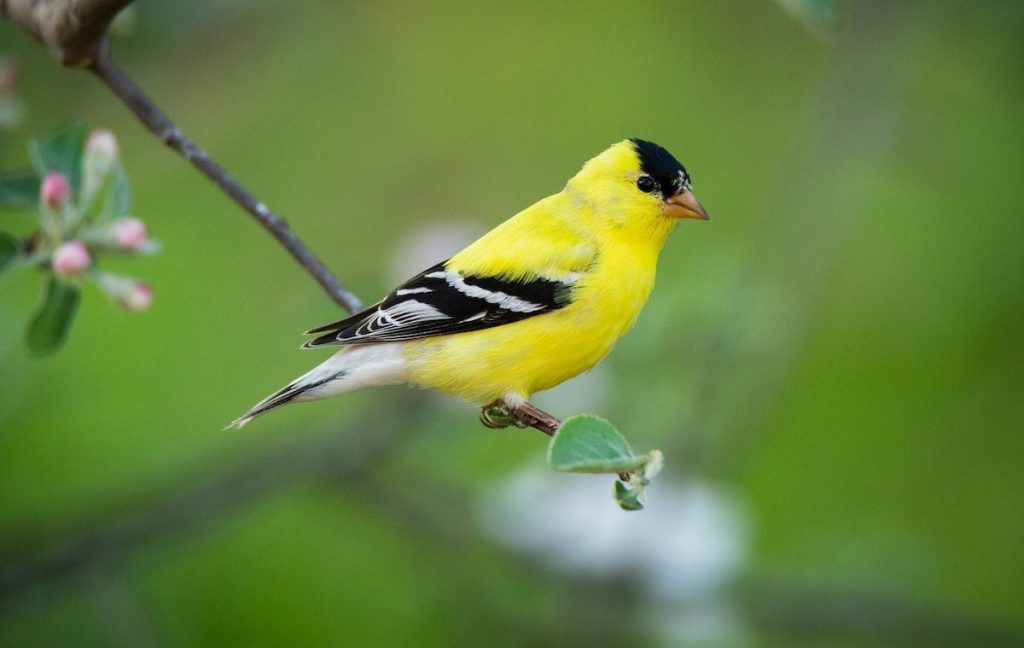
American Goldfinches are primarily spotted during winter in Florida, typically from November to April. Their presence is recorded in approximately 8% of winter checklists.
These popular birds are known for the bright yellow and black plumage displayed by males during the spring. Females, as well as males in winter, exhibit a duller brown appearance.
Characteristics:
– Length: 4.3-5.1 inches (11-13 cm)
– Weight: 0.4-0.7 ounces (11-20 g)
– Wingspan: 7.5-8.7 inches (19-22 cm)
American Goldfinches can be found across most of North America and are often resident year-round. However, those breeding in Canada and the Midwest migrate to southern US states for the winter.
These finches inhabit weedy fields, overgrown areas, suburbs, parks, and backyards. Their diet primarily consists of sunflower seeds, thistle, and aster plants during the breeding season, while they also visit bird feeders and consume sunflower and nyjer seeds.
By gaining a deeper understanding of the various yellow birds found in Florida, including their characteristics, habits, and migratory patterns, you’ll be better equipped to appreciate and identify these avian treasures.
11. Cedar Waxwing
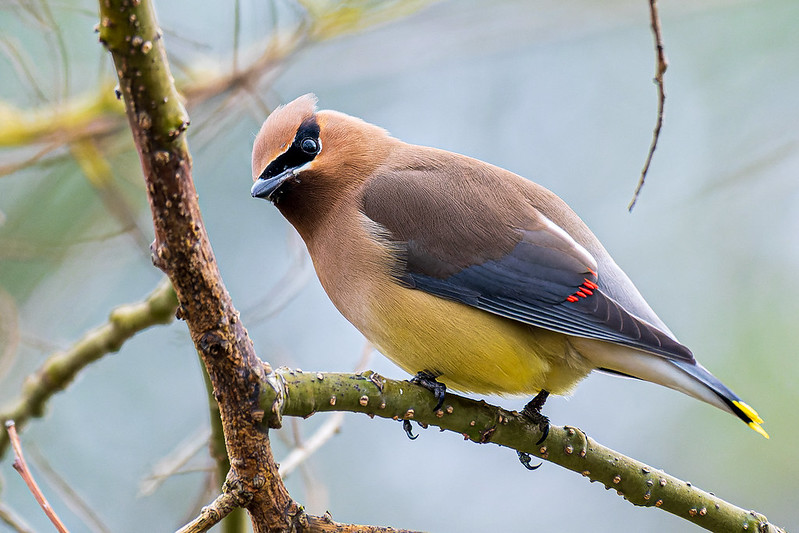
Cedar Waxwings are sporadically seen in Florida during the winter months. Their arrival begins in November and extends through April. They account for approximately 3% of winter checklists.
These elegant birds showcase a sleek blend of gray, brown, and yellow tones. They have distinctive crested heads, black masks, and wax-like red tips on their secondary wing feathers.
Characteristics:
– Length: 6.7-7.5 inches (17-19 cm)
– Weight: 1.1-1.6 ounces (30-45 g)
– Wingspan: 11.8-12.6 inches (30-32 cm)
Cedar Waxwings breed across Canada, Alaska, and portions of the United States. During winter, they migrate southward in search of fruit-bearing trees and shrubs. They are often seen in flocks and have a unique habit of passing berries from one bird to another.
12. Orange-crowned Warbler
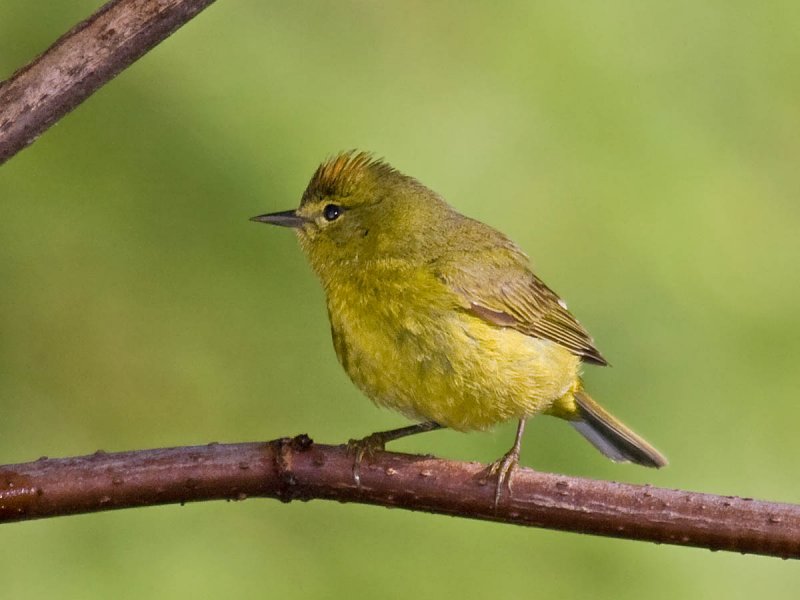
Orange-crowned Warblers can be spotted in Florida during winter, typically from October to April. They are present in approximately 4% of winter checklists.
These warblers have mostly olive-green plumage, with a hint of yellow on their undersides. While their name suggests an orange crown, it is often inconspicuous and not easily visible.
Characteristics:
– Length: 4.7 inches (12 cm)
– Weight: 0.3-0.4 ounces (8-11 g)
– Wingspan: 7.9 inches (20 cm)
Orange-crowned Warblers breed in northern North America and parts of the western United States. During winter, they migrate to southern regions, including Florida. They inhabit a variety of habitats, such as shrubby areas, woodlands, and gardens, where they forage for insects.
13. Baltimore Oriole
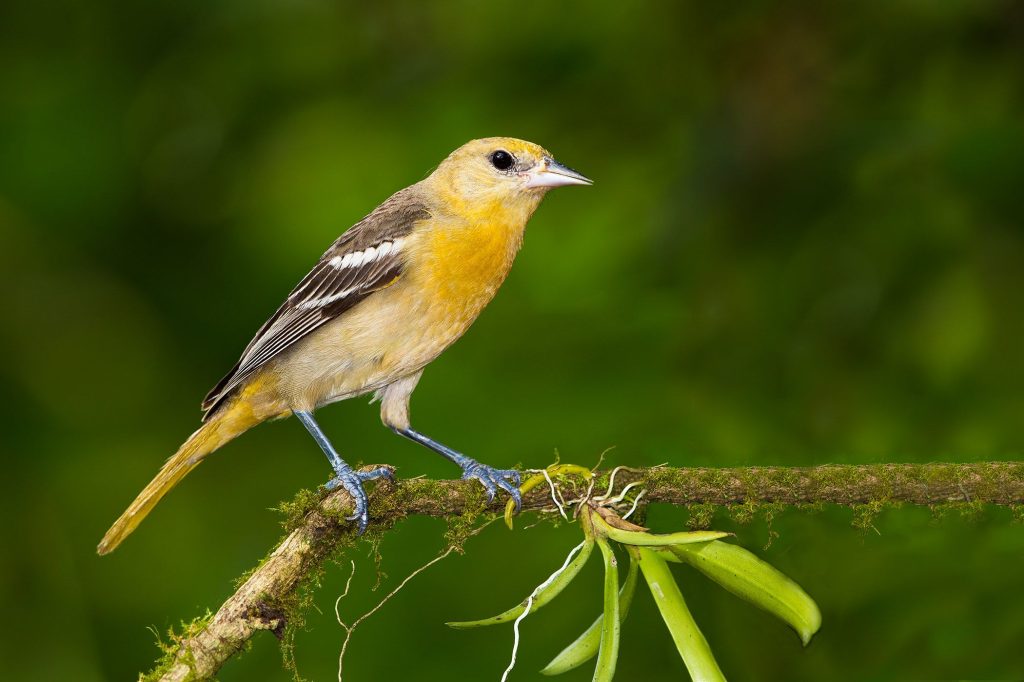
Baltimore Orioles are occasional visitors to Florida during winter, although their primary range is in the northeastern and midwestern parts of the United States. They account for approximately 2% of winter checklists.
Males exhibit stunning orange plumage with black accents, while females have a more subdued combination of yellow and olive tones.
Characteristics:
– Length: 7-7.5 inches (18-19 cm)
– Weight: 1-1.3 ounces (28-37 g)
– Wingspan: 9-12 inches (23-30 cm)
Baltimore Orioles breed in eastern North America and migrate to Central and South America during winter. In Florida, they can be found in parks, gardens, and wooded areas. Their diet primarily consists of nectar, fruit, and insects.
14. Black-throated Green Warbler
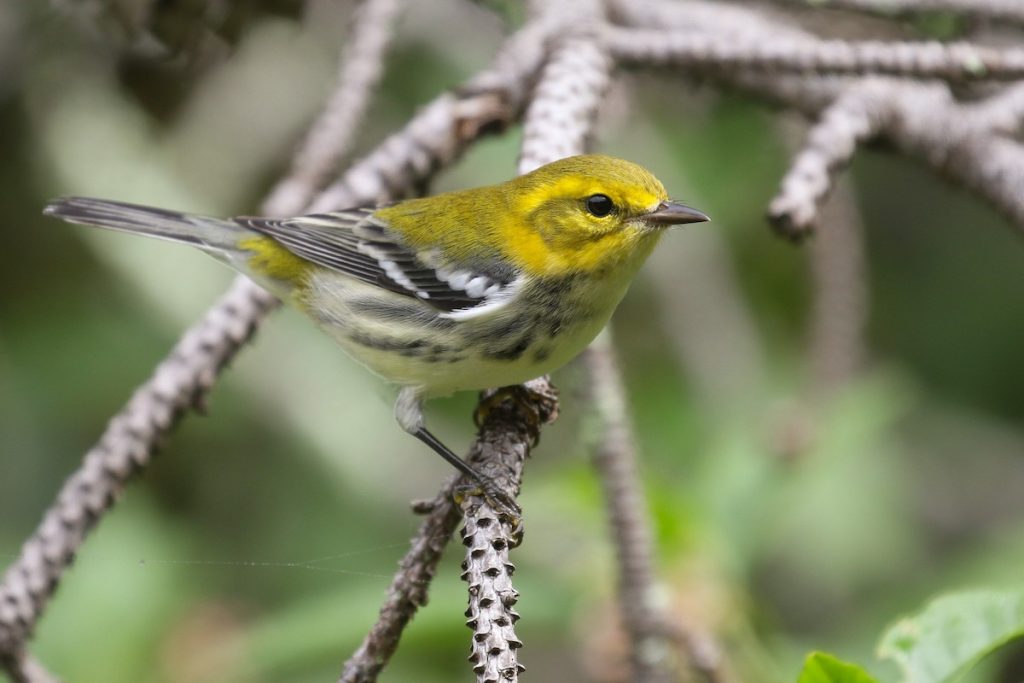
Black-throated Green Warblers are occasional winter visitors to Florida, mainly seen from October to April. They account for approximately 1% of winter checklists.
These warblers feature olive-green plumage with a distinctive black throat patch in males. Females have more subdued coloration and lack the black throat.
Characteristics:
– Length: 4.7-5.1 inches (12-13 cm)
– Weight: 0.3-0.4 ounces (9-11 g)
– Wingspan: 7.5-8.7 inches (19-22 cm)
Black-throated Green Warblers breed in boreal and northern forests of North America and migrate to the Caribbean, Central America, and parts of South America during winter. They can be found in various forest habitats, foraging for insects among tree foliage.
15. Western Kingbird
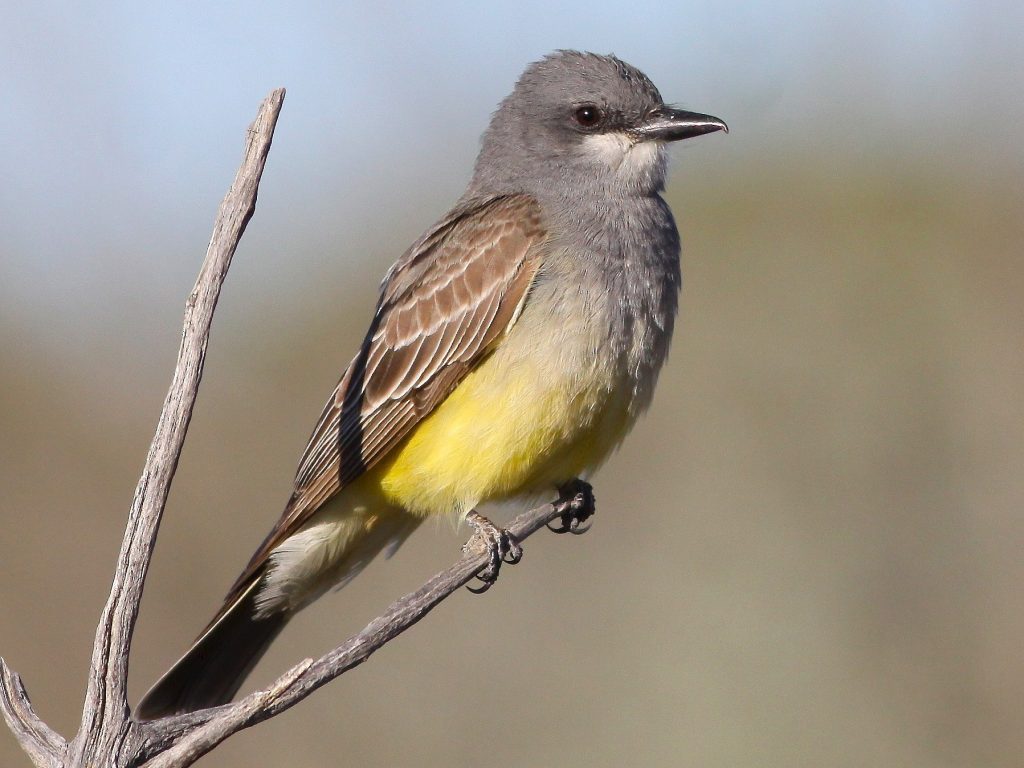
Western Kingbirds are accidental visitors to Florida, meaning their sightings are infrequent and outside their typical range. They have been observed in various parts of the state.
These kingbirds display a combination of gray and yellow plumage, with a pale belly and a distinctive white outer tail feather.
Characteristics:
– Length: 7.5-8.7 inches (19-22 cm)
– Weight: 1.1-1.5 ounces (32-43 g)
– Wingspan: 14.6-15.4 inches (37-39 cm)
Western Kingbirds breed in western North America and migrate to Mexico, Central America, and South America during winter. They prefer open habitats such as fields, meadows, and forest edges, where they catch insects on the wing.
16. Western Tanager
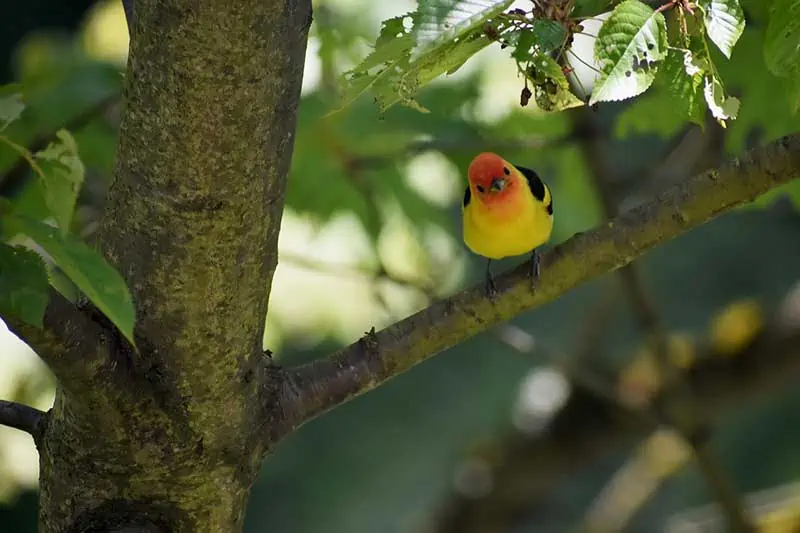
Western Tanagers are accidental visitors to Florida, occasionally sighted in the state. They have been reported in various locations.
Male Western Tanagers showcase vibrant yellow plumage with orange-red heads and black wings. Females have a more subdued combination of yellow and olive tones.
Characteristics:
– Length: 6.3-7.1 inches (16-18 cm)
– Weight: 0.6-1 ounce (17-28 g)
– Wingspan: 9.8-11 inches (25-28 cm)
Western Tanagers breed in coniferous forests of western North America and migrate to Mexico and Central America during winter. They forage for insects and fruits in trees and shrubs, often attracting attention with their distinctive calls.
17. Wilson’s Warbler
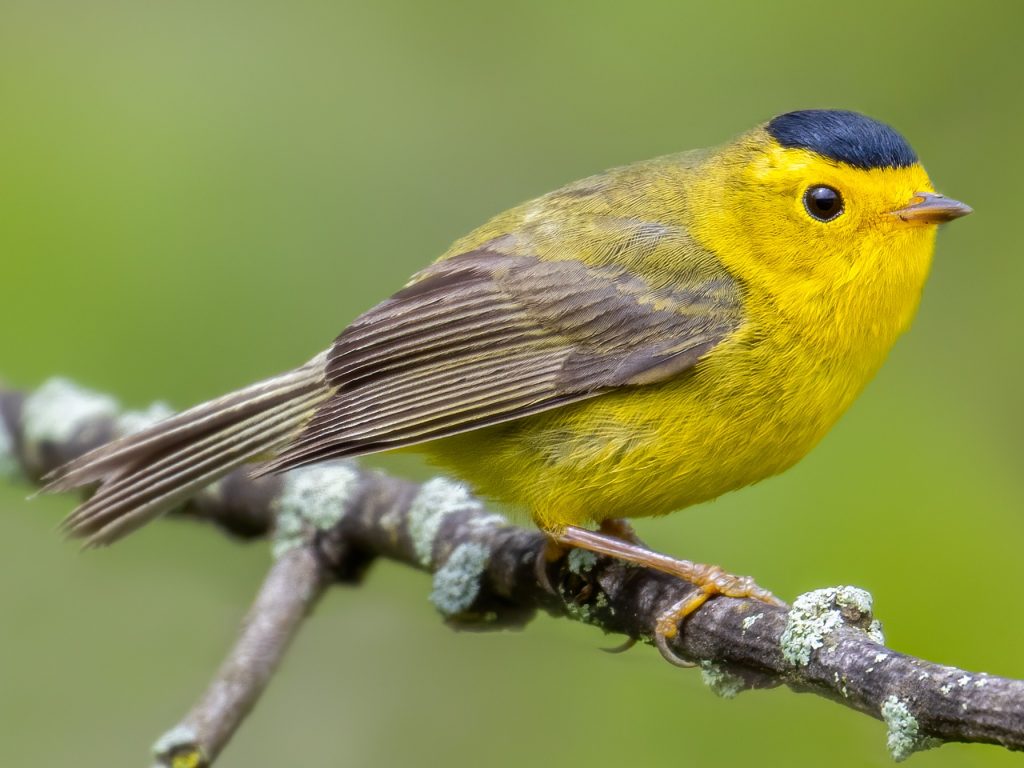
Wilson’s Warblers are occasional winter visitors to Florida, seen from October to April. They account for approximately 2% of winter checklists.
These warblers have bright yellow plumage with a distinct black cap on males. Females exhibit a similar pattern but with a duller appearance.
Characteristics:
– Length: 4.3 inches (11 cm)
– Weight: 0.3-0.4 ounces (9-11 g)
– Wingspan: 6.7-7.5 inches (17-19 cm)
Wilson’s Warblers breed in western North America and migrate to Mexico, Central America, and the Caribbean during winter. They favor habitats near water, such as wetlands and streamside vegetation, where they search for insects.
18. Yellow-headed Blackbird
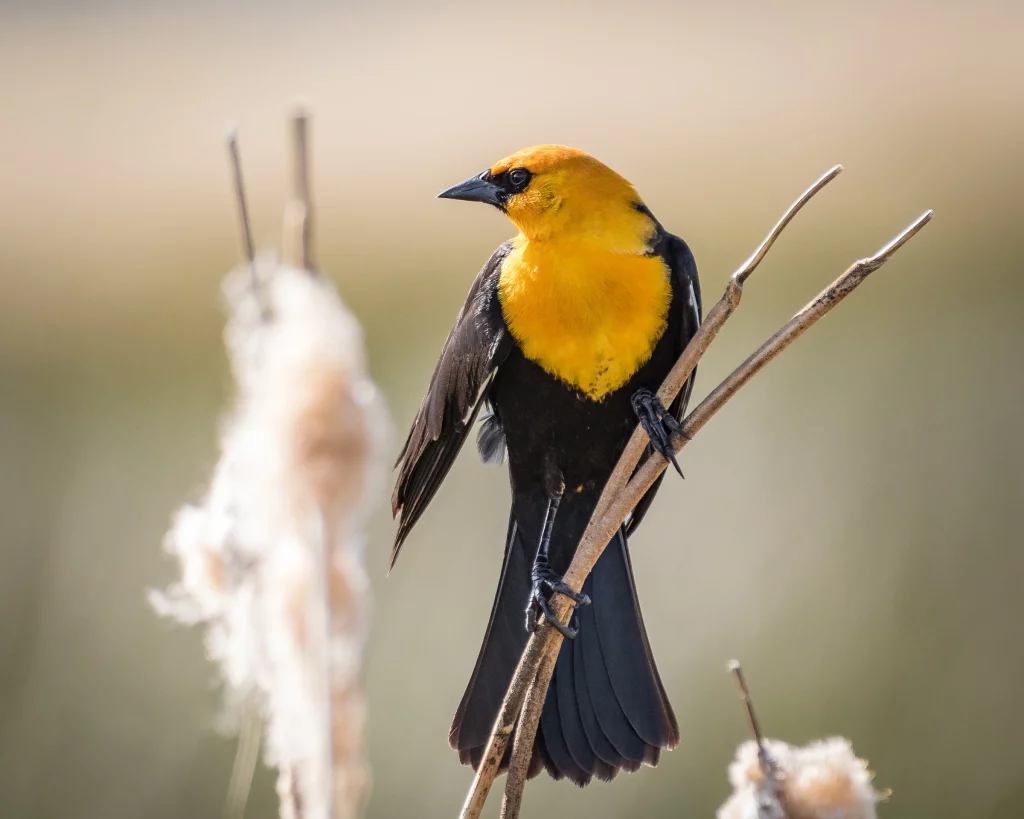
Yellow-headed Blackbirds are accidental visitors to Florida, occasionally spotted in the state. They have been observed in various locations.
Male Yellow-headed Blackbirds are characterized by their striking black bodies and bright yellow heads. Females exhibit a more subdued combination of brown and yellow tones.
Characteristics:
– Length: 8.7-9.8 inches (22-25 cm)
– Weight: 3.1-4.5 ounces (88-128 g)
– Wingspan: 14.6-16.5 inches (37-42 cm)
Yellow-headed Blackbirds breed in western North America and migrate to southwestern United States and Mexico during winter. They inhabit marshes, wetlands, and open fields, often forming large colonies. Their diet consists of seeds, insects, and aquatic invertebrates.
19. Tropical Kingbird
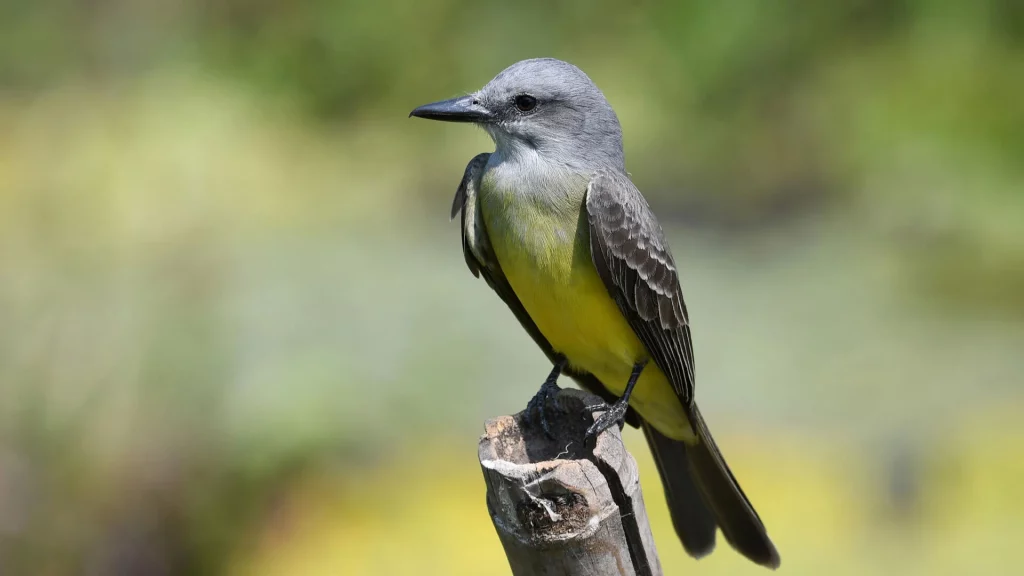
Tropical Kingbirds are accidental visitors to Florida, occasionally sighted in the state. They have been reported in various locations.
These kingbirds showcase a combination of grayish-olive upperparts, yellow underparts, and a distinct white throat patch.
Characteristics:
– Length: 7.5-9 inches (19-23 cm)
– Weight: 1.2-1.6 ounces (34-46 g)
– Wingspan: 15.4-16.1 inches (39-41 cm)
Tropical Kingbirds breed in the tropics of Central and South America and migrate northward to parts of the United States during summer. They prefer open habitats such as forest edges, farmlands, and gardens, where they catch insects in mid-air.
20. Hooded Oriole
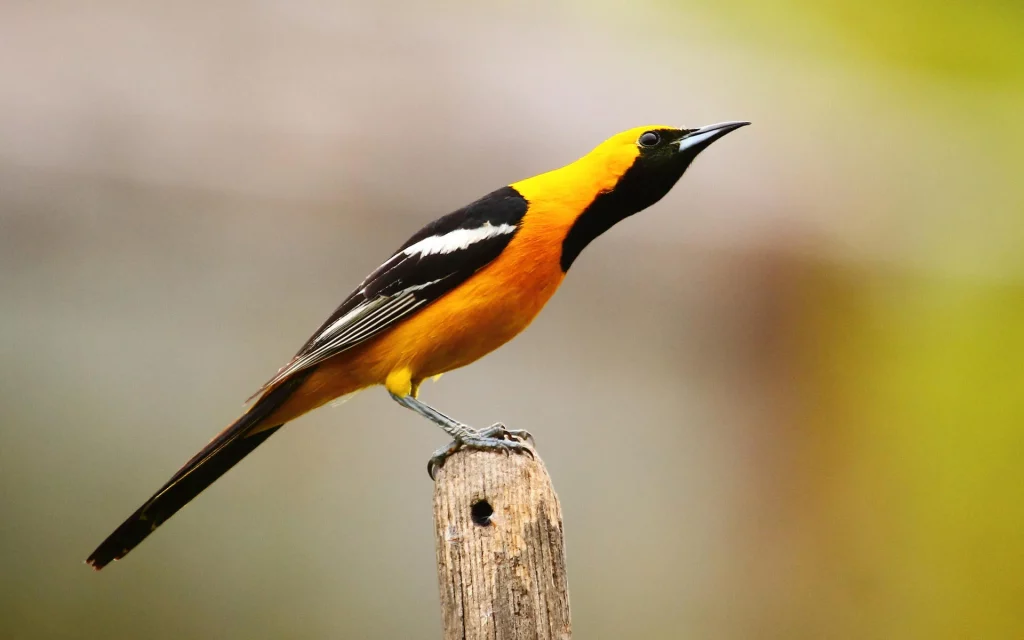
Hooded Orioles are accidental visitors to Florida, occasionally seen in the state. They have been reported in various locations.
Male Hooded Orioles exhibit a vibrant combination of black and bright yellow plumage, with a distinctive black bib. Females have a more subdued combination of yellow and olive tones.
Characteristics:
– Length: 7.5 inches (19 cm)
– Weight: 1 ounce (28 g)
– Wingspan: 9.4 inches (24 cm)
Hooded Orioles breed in southwestern United States and Mexico and migrate to Mexico and Central America during winter. They inhabit open woodlands, palm groves, and gardens, where they feed on nectar, fruit, and insects.
21. Scott’s Oriole
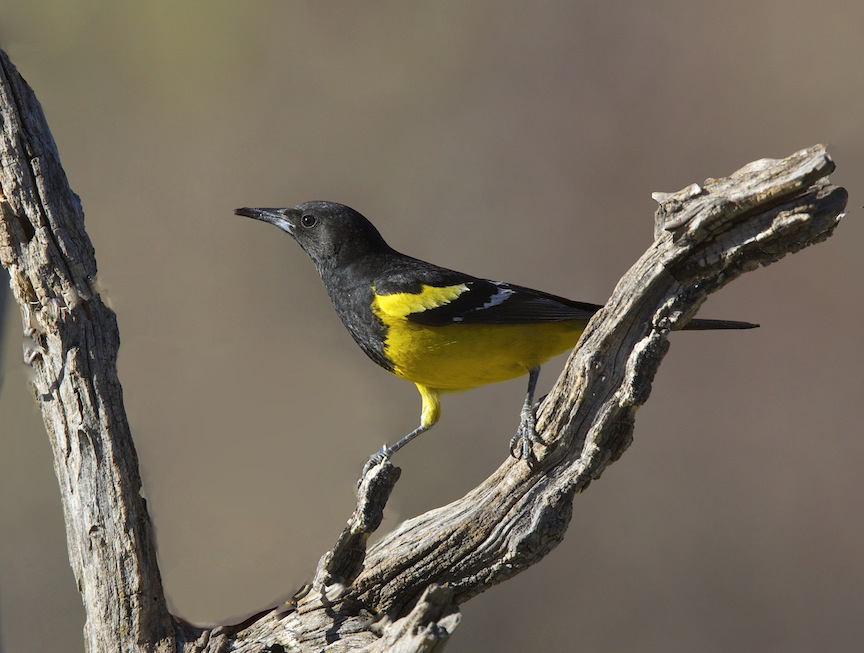
Scott’s Orioles are accidental visitors to Florida, occasionally sighted in the state. They have been reported in various locations.
Male Scott’s Orioles showcase a striking combination of black and bright yellow plumage, with a black throat and face. Females have a more subdued combination of yellow and olive tones.
Characteristics:
– Length: 8-9 inches (20-23 cm)
– Weight: 1-1.4 ounces (28-40 g)
– Wingspan: 12-13 inches (30-33 cm)
Scott’s Orioles breed in arid regions of southwestern United States and northern Mexico and migrate to Mexico and Central America during winter. They favor desert habitats with scattered trees and cacti, where they feed on nectar, fruit, and insects.
22. Western Meadowlark

Western Meadowlarks are accidental visitors to Florida, occasionally observed in the state. They have been reported in various locations.
These meadowlarks exhibit a combination of brown, black, and yellow plumage, with distinct V-shaped black markings on their chests.
Characteristics:
– Length: 7.5-10 inches (19-25 cm)
– Weight: 3.5-5.3 ounces (99-150 g)
– Wingspan: 14.6-16.5 inches (37-42 cm)
Western Meadowlarks breed across western North America and migrate to southern United States and Mexico during winter. They inhabit grasslands, prairies, and open fields, where they forage for insects and seeds.
23. Evening Grosbeak

Evening Grosbeaks are accidental visitors to Florida, occasionally seen in the state. They have been reported in various locations.
Male Evening Grosbeaks exhibit a striking combination of black, white, and yellow plumage. Females have a more subdued combination of gray, yellow, and white tones.
Characteristics:
– Length: 7.5-8.7 inches (19-22 cm)
– Weight: 1.8-2.5 ounces (52-71 g)
– Wingspan: 12.2-14.6 inches (31-37 cm)
Evening Grosbeaks breed across northern North America and migrate southward irregularly during winter. They inhabit coniferous forests and feed on seeds, berries, and insects.
24. Lesser Goldfinch
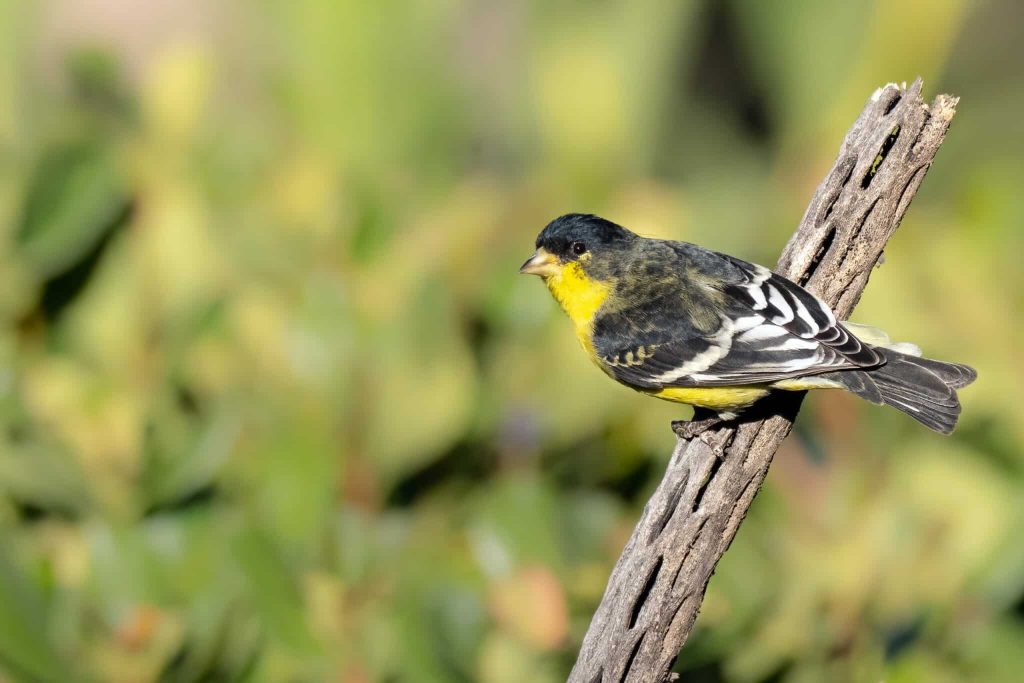
Lesser Goldfinches are accidental visitors to Florida, occasionally sighted in the state. They have been reported in various locations.
These small finches showcase a combination of black and yellow plumage. Adult males have a black back and cap, while females and juveniles have a more subdued combination of greenish-black and yellow tones.
Characteristics:
– Length: 4-4.5 inches (10-11 cm)
– Weight: 0.3-0.4 ounces (9-11 g)
– Wingspan: 6.7-7.5 inches (17-19 cm)
Lesser Goldfinches breed in southwestern United States and Mexico and migrate to Mexico, Central America, and northern South America during winter. They inhabit scrublands, woodlands, and gardens, where they feed on seeds, berries, and insects.
25. Couch’s Kingbird

Couch’s Kingbirds are accidental visitors to Florida, occasionally seen in the state. They have been reported in various locations.
These kingbirds exhibit a combination of grayish-olive upperparts and yellow underparts, with a distinct white throat and belly.
Characteristics:
– Length: 8.3-9.4 inches (21-24 cm)
– Weight: 1.6-2 ounces (45-57 g)
– Wingspan: 15-16.5 inches (38-42 cm)
Couch’s Kingbirds breed in southwestern United States and northern Mexico and migrate to Mexico, Central America, and the Caribbean during winter. They prefer open habitats such as woodlands, grasslands, and urban areas, where they catch insects on the wing.
26. Eastern Yellow Wagtail
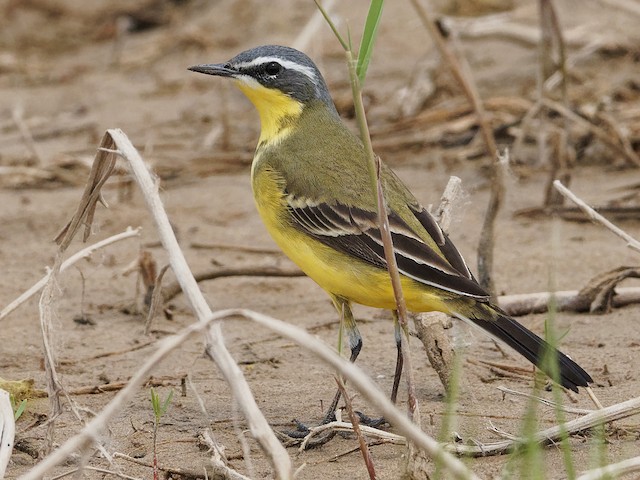
Eastern Yellow Wagtails are accidental visitors to Florida, occasionally observed in the state. They have been reported in various locations.
These wagtails showcase a combination of olive-green upperparts, bright yellow underparts, and a distinct yellow face.
Characteristics:
– Length: 6-6.7 inches (15-17 cm)
– Weight: 0.6-0.7 ounces (17-20 g)
– Wingspan: 9.1-9.8 inches (23-25 cm)
Eastern Yellow Wagtails breed in eastern Asia and migrate to southern Asia and parts of Africa during winter. Their sightings in Florida are considered rare and occur as vagrants. They inhabit wetlands, grasslands, and rice fields, where they forage for insects and small invertebrates.
27. American Redstart

American Redstarts are migratory visitors to Florida, primarily seen during spring and fall migrations. They account for approximately 4% of checklists during migration.
Male American Redstarts exhibit a striking combination of black, orange, and white plumage, with tail feathers that flash open during their display flights. Females have a more subdued combination of gray, yellow, and white tones.
Characteristics:
– Length: 4.3-5.1 inches (11-13 cm)
– Weight: 0.3-0.4 ounces (9-11 g)
– Wingspan: 6.3-7.5 inches (16-19 cm)
American Redstarts breed in eastern North America and Canada and migrate to Central and South America during winter. They inhabit various forest habitats, where they actively forage for insects by hopping and fluttering among tree branches.
28. Cape May Warbler
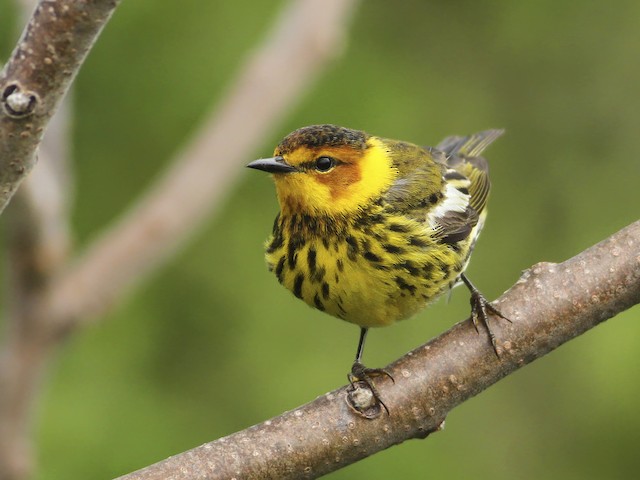
Cape May Warblers are migratory visitors to Florida, primarily seen during spring and fall migrations. They account for approximately 2% of checklists during migration.
These warblers display a combination of yellow, olive, and black plumage, with distinct chestnut cheek patches.
Characteristics:
– Length: 4.3-5.1 inches (11-13 cm)
– Weight: 0.3-0.4 ounces (9-11 g)
– Wingspan: 7.5-8.7 inches (19-22 cm)
Cape May Warblers breed in northern North America, primarily in Canada, and migrate to the Caribbean and Central America during winter. They prefer coniferous and mixed forests, where they feed on insects and nectar.
29. Yellow Warbler
Yellow Warblers are migratory visitors to Florida, primarily seen during spring and fall migrations. They account for approximately 6% of checklists during migration.
Male Yellow Warblers exhibit bright yellow plumage with reddish streaks on their chests. Females have a more subdued combination of yellow and olive tones.
Characteristics:
– Length: 4.7 inches (12 cm)
– Weight: 0.3-0.4 ounces (9-11 g)
– Wingspan: 6.7-7.5 inches (17-19 cm)
Yellow Warblers breed across North America and migrate to Central and South America during winter. They inhabit various habitats, including forests, wetlands, and gardens, where they actively forage for insects and spiders.
30. Blackburnian Warbler
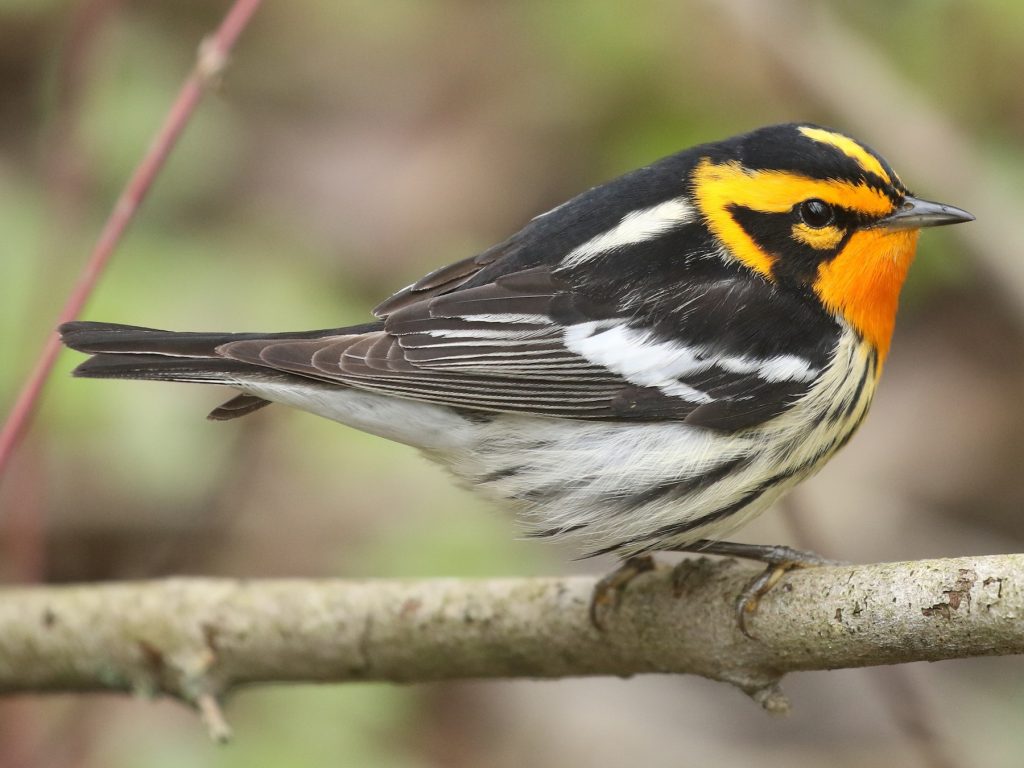
Blackburnian Warblers are migratory visitors to Florida, primarily seen during spring and fall migrations. They account for approximately 2% of checklists during migration.
Male Blackburnian Warblers exhibit a striking combination of orange, black, and white plumage, with a bright orange throat. Females have a more subdued combination of yellow and olive tones.
Characteristics:
– Length: 4.3-5.1 inches (11-13 cm)
– Weight: 0.3-0.4 ounces (9-11 g)
– Wingspan: 7.1-8.3 inches (18-21 cm)
Blackburnian Warblers breed in northeastern North America and migrate to Central and South America during winter. They favor coniferous and mixed forests, where they actively forage for insects among tree foliage.
31. Chestnut-sided Warbler
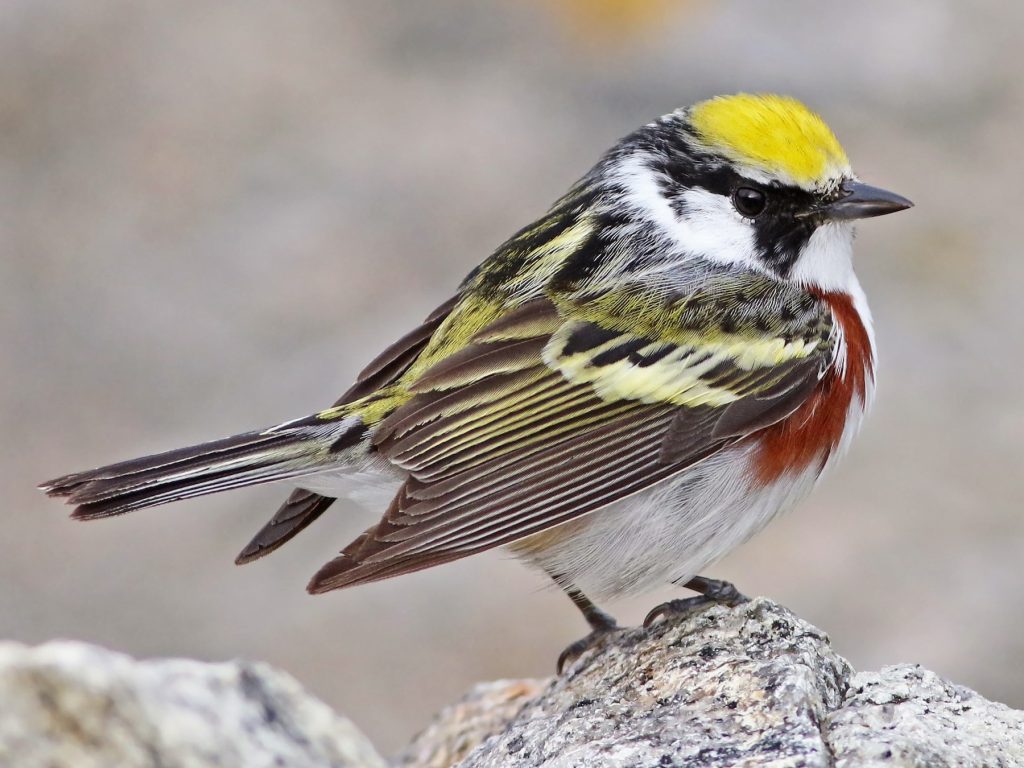
Chestnut-sided Warblers are migratory visitors to Florida, primarily seen during spring and fall migrations. They account for approximately 3% of checklists during migration.
These warblers display a combination of yellow, chestnut, and gray plumage, with distinct chestnut-colored patches on their sides.
Characteristics:
– Length: 4.7 inches (12 cm)
– Weight: 0.3-0.4 ounces (9-11 g)
– Wingspan: 7.5-8.3 inches (19-21 cm)
Chestnut-sided Warblers breed in northeastern North America and Canada and migrate to Central and South America during winter. They inhabit various forest habitats, including deciduous and mixed forests, where they actively forage for insects.
32. Tennessee Warbler

Tennessee Warblers are migratory visitors to Florida, primarily seen during spring and fall migrations. They account for approximately 2% of checklists during migration.
These warblers have a combination of olive, gray, and yellow plumage, with a pale eye ring.
Characteristics:
– Length: 4.3-5.1 inches (11-13 cm)
– Weight: 0.3-0.4 ounces (9-11 g)
– Wingspan: 7.1-7.9 inches (18-20 cm)
Tennessee Warblers breed in boreal forests of Canada and Alaska and migrate to Central and South America during winter. They inhabit various forest habitats, including coniferous and mixed forests, where they actively forage for insects.
Please note that the list provided above is not exhaustive, and there may be additional bird species that have been observed in Florida as occasional or rare visitors. Bird sightings can vary, and it’s always recommended to consult local birding resources and guides for the most up-to-date and accurate information.
